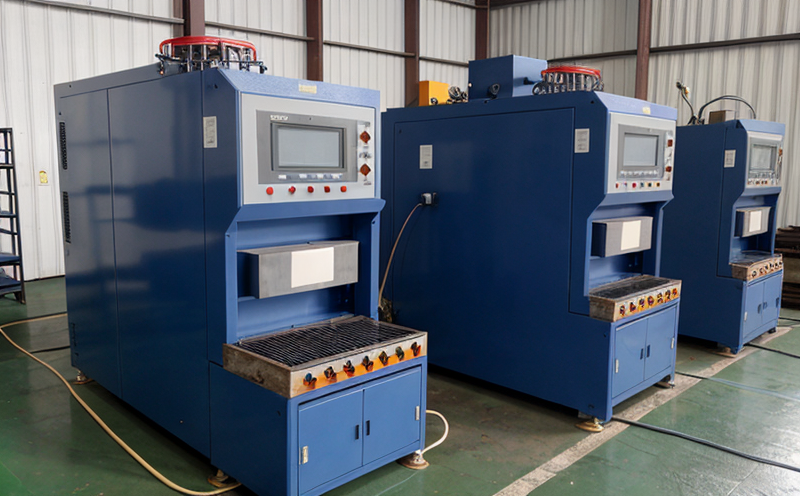NF EN 197 Cement Composition Testing
The NF EN 197 series of standards provides a comprehensive framework for the production and quality control of Portland cement. Among these, EN 197-1:2018 specifies the chemical composition requirements for clinker used in the manufacture of portland cement. This test is essential for ensuring that raw materials meet the necessary specifications before they are blended into the final product.
The primary objective of this testing procedure is to ensure consistent quality and compliance with international standards, which is critical for the reliability and performance of concrete products derived from the cement. The test measures key elements such as calcium oxide (CaO), silicon dioxide (SiO₂), aluminium oxide (Al₂O₃), iron trioxide (Fe₂O₃), titanium dioxide (TiO₂), magnesium oxide (MgO), sulphur trioxide (SO₃), and loss on ignition (LOI). These elements play crucial roles in the hydration process of cement, influencing its setting time, strength development, durability, and overall performance.
The test typically involves several steps. Initially, a representative sample of raw materials is collected from the batching plant or storage facility. The sample must be homogenized to ensure that it accurately represents the batch being tested. After homogenization, the sample is dried in an oven at 105°C ± 2°C until constant weight is achieved.
Once dried, the sample undergoes analysis using various techniques such as X-ray fluorescence (XRF) spectrometry or near-infrared spectroscopy (NIRS). These methods provide precise quantitative data on the elemental composition of the raw materials. The results are then compared against the specified limits outlined in EN 197-1:2018 to determine compliance.
The accuracy and reliability of this test are paramount, as deviations from the prescribed ranges can lead to substandard cement production. For instance, if there is an excess of iron trioxide (Fe₂O₃) or titanium dioxide (TiO₂), it may indicate contamination with certain raw materials like blast furnace slag or fly ash. On the other hand, insufficient levels of calcium oxide (CaO) could result in slower setting times and reduced early-age strength.
In addition to ensuring compliance with regulatory requirements, this test also supports continuous improvement efforts within industrial manufacturing processes. By regularly monitoring the elemental composition of raw materials, manufacturers can identify trends that may indicate process inefficiencies or raw material quality issues. This information is invaluable for optimizing production efficiency and maintaining high-quality output consistently.
The importance of this testing cannot be overstated, especially in industries where reliability and performance are critical factors. For example, construction projects reliant on concrete strength and durability must ensure that the cement used meets stringent standards to guarantee long-term integrity and safety. Similarly, environmental regulations often require compliance with specific limits for certain elements like sulphur trioxide (SO₃) and magnesium oxide (MgO), further emphasizing the necessity of accurate composition testing.
Furthermore, adherence to international standards like EN 197-1:2018 fosters global interoperability and trust among manufacturers, suppliers, and end-users. This standardization helps streamline supply chains and facilitates easier collaboration across borders, which is particularly beneficial in today’s interconnected marketplaces.
Why Choose This Test
- Ensures Compliance with International Standards: By adhering to EN 197-1:2018, you can guarantee that your cement meets the highest quality standards set by international bodies.
- Promotes Consistency in Quality: Regularly testing raw materials helps maintain consistent product quality throughout production runs.
- Facilitates Regulatory Compliance: Many regions have strict regulations regarding cement composition, and this test ensures that your products meet these requirements.
- Enhances Product Reliability: Accurate elemental analysis leads to more reliable construction materials with predictable performance characteristics.
- Saves Costs in the Long Run: By identifying issues early through rigorous testing, you avoid costly rework and product recalls later on.
- Promotes Sustainable Practices: Monitoring raw material composition allows for adjustments that can minimize waste and reduce environmental impact.
International Acceptance and Recognition
The NF EN 197 series of standards, including EN 197-1:2018, has gained widespread acceptance across Europe and beyond. These standards are recognized by numerous international organizations such as the International Organization for Standardization (ISO) and the European Committee for Standardization (CEN).
The use of these standards ensures that manufacturers adhere to consistent quality benchmarks, which is particularly important in industries where standardization enhances global trade and cooperation. For example, construction companies operating internationally can rely on cement that meets the same quality criteria regardless of location.
Moreover, adherence to EN 197-1:2018 provides a competitive edge by demonstrating commitment to excellence and reliability. This is especially valuable in sectors where reputation and trust are key factors, such as infrastructure development or large-scale construction projects.
The widespread recognition of these standards also facilitates smoother regulatory processes. Regulatory bodies often accept compliance with international standards as evidence of quality control measures, streamlining the approval process for new products or materials entering different markets.
Environmental and Sustainability Contributions
Incorporating NF EN 197 Cement Composition Testing into your industrial processes can have significant environmental benefits. By ensuring that raw materials meet strict elemental composition criteria, you contribute to more sustainable manufacturing practices.
One key aspect is the reduction of waste generation. Accurate testing allows for precise adjustments in raw material inputs, minimizing overuse and underuse scenarios which lead to unnecessary production scrap or energy consumption. This efficiency not only cuts costs but also reduces environmental impact by lowering resource extraction rates.
Another important factor is reduced emissions during cement manufacturing. Ensuring that the right proportions of each element are present helps optimize combustion processes within kilns, reducing CO₂ emissions per tonne of cement produced. Additionally, the use of certain raw materials like fly ash can replace some of the Portland clinker content, further decreasing overall carbon footprints.
Furthermore, compliance with EN 197-1:2018 supports circular economy principles by encouraging resource recycling and reutilization. For instance, using slag or other industrial by-products as supplementary cementitious materials can extend raw material lifecycles while providing comparable performance benefits in concrete mixes.
The commitment to environmental sustainability through rigorous testing aligns with broader corporate social responsibility goals. It demonstrates a proactive approach towards minimizing ecological footprints and promoting responsible resource use within the manufacturing sector.





